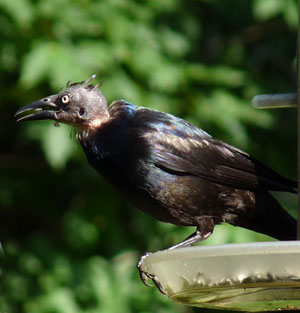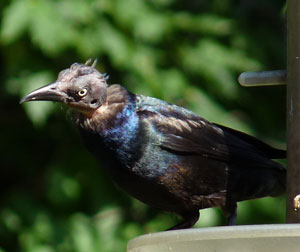Last week I was trying out the 18x optical zoom on my new Lumix camera. I snapped a few shots of a thuggish Common Grackle shoveling seed out of our birdfeeder. When I zoomed in on the camera’s display, I noticed its hideous head (see photo). Turkey vultures don’t have feathers on their head, but I was not expecting to see a denuded head on another species. It is not a good look for a bird.
Apparently every year, people report cases of bald-headed birds at their feeders – typically Blue Jays and Northern Cardinals, and sometimes grackles. There are a couple of possible explanations for this phenomenon, according to the website for Project FeederWatch, a research and education project of Cornell Lab of Ornithology and Bird Studies Canada.
 |
 |
| This mangy looking Common Grackle (Quiscalus quiscula) was spotted emptying a Woodstock CT birdfeeder in July 2009. Photo by Bet Zimmerman. Download larger photo 1 | photo 2 |
Since most bald birds are seen in the summer and the fall, the molting process may have malfunctioned. Molting is replacement of feathers. “Many of these strange-looking birds may be juveniles undergoing their first prebasic molt, which produces the first winter adult plumage. For some unknown reason, the bald birds may have dropped all of their head feathers at once,” notes the website. “Staggered feather replacement is the normal pattern.”
The avian unsightliness might also be due to an attack of parasites. Feather mites or lice are tiny arthropods commonly found on birds. When they feed, they destroy the shafts of feathers. Birds preen to get rid of these buggers, but they can’t reach their heads with their beaks. Thus it is the most vulnerable spot, and probably the cause of balding, according to Mark Monroe, a biologist at the Hawk Mountain Sanctuary in Pennsylvania.
I asked Linda Ruth, a retired veterinarian and friend in Coventry, about my unattractive visitor. She too suspected molting or parasites. She noted that some forms of ringworm attack only the head, but there are usually crusty patches as well. (Despite the name, ringworm is a fungus, not a worm. Some forms of ringworm can also infect humans.) “A rare autoimmune disease called Pemphigus has also been known to cause this, but, again, there are usually crusts and sores.”
“This bird reminds me of a cat I treated once,” recalled Linda. “The cat was completely bald from the neck up. I couldn't imagine what in the world had caused it. It turns out that the owner was a beautician. Her four year old daughter was imitating mommy doing a perm on someone's hair. She somehow got a hold of some perm solution, carefully wrapped a towel around the cat's neck (just like mommy), and poured the stuff on the poor cat's head. I'll never know how she avoided blinding the cat, but it was fine. Its fur grew back in about three months.“
It’s not clear to me why the phenomenon is not seen much on other bird species, since most birds have feather mites and lice. Project FeederWatch says bird balding could also be associated with some environmental or nutritional factor. With regard to the cause, “No one knows for sure, and the condition has not been well studied,” say the Project website. “Fortunately, new head feathers grow in within a few weeks. “ Otherwise, if this grackle were a male, he might have a tough time snagging “chicks” next breeding season.
For more information on Project FeederWatch, see http://www.birds.cornell.edu/pfw/Overview/whatispfw.htm.
|

